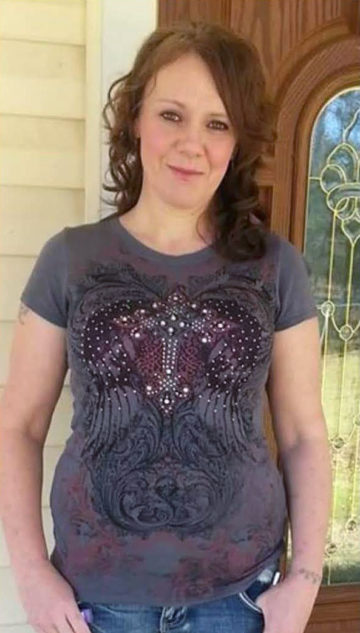
How Texas Jails Avoid Investigations of Inmate Deaths
Every Texas jail death is supposed to be investigated. But a recent case shows how facilities skirt the law and avoid scrutiny.

Early last year, Holly Barlow-Austin cut off her ankle monitor and headed to Dallas. She lived with her husband in Texarkana, a small town on the border of Texas and Arkansas. But despite the restrictions of her probation, she decided she needed to check herself into a rehabilitation center about three hours southwest of her home.
Drugs had tormented her for years. Barlow-Austin, who was HIV positive and had bipolar disorder, had been in and out of the Dallas County jail and the Bi-State jail near her home in Bowie County on cocaine, marijuana, and prostitution charges. But she had tried to straighten her life up in recent years, says her cousin, Stacy Barlow. She seemed happier.
Still, she relapsed. She used cocaine multiple times in the summer and fall of 2018. By February 2019, Barlow-Austin was ready to get help. She stayed at the Dallas rehab facility for a month. Days after she arrived back home, a police officer arrested her for violating her probation, and took her back to the Bi-State jail.
When Barlow-Austin, then 47, entered the jail, her vital signs were normal. Two months later, she was taken to a hospital, where she was given IV fluids and put on a feeding tube. There, the doctor found that her optic nerve was swollen, a sign that pressure was building in her skull. Her pupils were dilated and would not respond to light, and the fluid inside her left eye was hazy. She complained that she couldn’t see. The doctor tried to flex her neck but couldn’t because it was so stiff. Her heart was beating as if she just ran a marathon. She couldn’t grip objects like a cup of water in her hands. She was so restless that doctors couldn’t take an MRI. She couldn’t walk. She didn’t know where or who she was.
Two days later, on June 17, 2019, she died in her hospital bed.

Barlow-Austin’s cause of death, according to the hospital, was high blood pressure and a type of fungal meningitis most commonly found in people with HIV/AIDS. But her family wouldn’t learn the details surrounding her death for months.
In the 24 hours after an inmate dies, jails are supposed to notify the Texas Commission on Jail Standards (TCJS) as well as an independent law enforcement agency—usually the Texas Rangers, the statewide group tasked with investigating issues like police corruption. But the Bi-State jail didn’t call or email either of them. Eventually, TCJS would inspect the jail’s care of Barlow-Austin, but the Rangers never investigated it for criminal wrongdoing. According to her family’s lawyer, no outside agency reviewed the jail’s video footage. No one formally interviewed her medical providers or the inmates nearby. No one asked a grand jury or prosecutor if the jail staff should be held accountable for Barlow-Austin’s death. All because—according to the jail—she was no longer under their care.
Since 2009, Texas county jails have been required to report all inmate deaths, and TCJS must inspect the jail to see if it violated minimum standards. With the passage of the Sandra Bland Act in 2017, every county jail death must also be investigated by an outside agency, often the Rangers, to determine if there was criminal wrongdoing. But in some cases, jails have skirted the law by abruptly releasing inmates from custody just before they died, like in the case of Barlow-Austin. As a result, these deaths haven’t been counted or criminally investigated “on multiple occasions,” according to a TCJS report from last year. This includes cases where apparent neglect or mistreatment by jail staff may have contributed to the death, and in Barlow-Austin’s case, where there was video documentation.
A recording four days before Barlow-Austin was transferred to the hospital shows her lying on her side, head in her hands. A guard asked if she wanted to see a doctor, and after her barely audible response, wrote down that she did not. “They don’t never do nothing,” she whispered. Two days later, a jail guard dragged her on a mat into a medical observation cell. There, she crawled around touching the white brick wall, knocking on the door and windows. She drank only three small cups of water and ate a few bites of food in her last two days there. At one point, she struggled to lift up a carton of food and it spilled on her mat; then she lay with her head in the mess. Much of her last night was spent on the concrete floor using her mat as a blanket or pulling her T-shirt over her knees. Guards were required to check on Barlow-Austin face-to-face every 30 minutes, but didn’t do so. Some peered in through the window, then walked away. A nurse came in her cell once to check her vitals. Ten hours later, the jail called 911.
Her husband says Barlow-Austin is “unrecognizable” in the videos. Her mother hasn’t watched them. “I couldn’t bear to see my baby suffer like that,” she says. In September, they filed a lawsuit against Bi-State officials, Bowie County, and LaSalle Corrections, the for-profit company that runs the jail, for depriving Barlow-Austin of medical care and housing her in inhumane conditions. (Her husband and mother declined to speak for this article, but sent comments through their attorney.) As of October, her death has yet to be criminally investigated by an outside law enforcement agency.
“The failure to investigate this atrocity is an atrocity in and of itself,” says Erik Heipt, the lawyer representing Barlow-Austin’s family, who obtained the videos through a records request. “Because if anyone dies in custody, there should at least be an outside agency that comes and investigates it.”
*
Eleven days after Barlow-Austin died, Tanya Eiserer, a Dallas-based journalist who covers criminal justice, wrote an email to Brandon Wood, the executive director of TCJS. “Has the jail commission been informed of a death in LaSalle’s Bowie County jail from within the last few weeks?” Eiserer wrote. “The person that died is named Holly Austin. I’m told it’s another alleged medical neglect issue.”
The commission hadn’t heard anything about Holly Barlow-Austin. No calls, no emails, nothing. It took another month, and a phone call from TCJS, before the jail officially filed an inmate death report.
After Barlow-Austin’s death, Wood says TCJS and the jail “argued back and forth” about one surprisingly divisive question: Did she die in custody?
Because the sheriff released her from custody before she died, jail staff argued that they didn’t need to report the death to TCJS or the Rangers, according to Wood. Jay Eason, LaSalle’s Director of Operations, told the Observer that the jail is unable to comment on her case due to the pending litigation. In an email he wrote, “We strive to provide services that are in compliance with local, state and federal standards.”
But Barlow-Austin’s release from jail was anything but typical, Wood says. Usually, before an inmate is released, a district attorney will drop the inmate’s charges or the inmate will sign a personal recognizance (PR) bond, a written agreement that they will appear in court. But when the sheriff released Barlow-Austin, for “medical reasons” according to her release papers, she was unable to sign anything. Her sister was asked to sign her release report only after the fact, even though the jail didn’t have her sister’s legal power of attorney. “We don’t think it was a valid release,” Wood said in an interview. “How are you going to argue that she was properly released if she couldn’t sign a PR bond?”
Wendy Wisneski, one of TCJS’ inspectors, found multiple violations in the jail’s care. A few days after Barlow-Austin was arrested, her husband brought a variety of medications to the jail—for her HIV, bipolar disorder, and to prevent fungal infections—but the name and type of medication wasn’t written in her medical records. On multiple occasions while in jail, she didn’t receive her prescribed medications. Despite Wisneski’s findings, the Texas Rangers never investigated Barlow-Austin’s death.
*
Given the lack of reporting, it’s hard to know how many times jails have failed to report cases when an inmate was released from custody shortly before dying. Krish Gundu, executive director of the Texas Jail Project, says she knows of seven cases like Barlow-Austin’s, where a jail initially didn’t report an inmate death because they claimed the person didn’t die in custody. That count includes the death of Christopher Duboise.
Five hundred miles away from the Bi-State jail, Duboise died shortly after being transferred to the hospital from the Midland County jail in May. But his death almost wasn’t reported and investigated, according to local Justice of the Peace David Cobos, who often certifies deaths since there is no medical examiner in the county. Duboise was arrested in 2019 for public intoxication, and this spring hung himself from a handicap bar in the county jail. He died at a local hospital a few days later.
According to Cobos, the hospital called him minutes after DuBoise died to certify his death. After Cobos spoke to police sergeants, he sensed that “something didn’t smell right.” He says staff at the sheriff’s department claimed that it wasn’t an in-custody death, repeating “he had a pulse when he left the jail.” (The Midland sheriff’s department did not respond to requests for comment.) Cobos soon found out that the sheriff released DuBoise shortly before he died, but in the spot where DuBoise was supposed to sign his bond, someone had written “unable to sign.” So Cobos called the Texas Rangers, who agreed to treat the case as an in-custody death and investigate. Cobos says it wasn’t until a Ranger met with the acting sheriff that the jail finally reported the death to TCJS.
“If the authorities don’t find out about it, then sometimes it just gets swept under the rug,” says Dean Malone, a Dallas-based lawyer who represents inmates and their families in wrongful death lawsuits. He says he’s seen counties fail to report a death for months. “It’s the honor system, if you think about it.”
While TCJS inspection reports are important, advocates say that a criminal investigation can bring more rigorous accountability. TCJS inspects jail deaths to see if the jail violated minimum standards, but outside law enforcement agencies, like the Texas Rangers, look for criminal misconduct. While it is very rare, investigations can result in criminal charges, like in the case of Savion Hall, who died shortly after being transferred from the Midland County jail to a hospital last year. Following a Texas Rangers’ investigation, a Midland County grand jury this summer indicted six jail nurses on charges of manslaughter, criminally negligent homicide, and knowingly falsifying medical records.
“There are likely systemic issues at play that the Texas Commission on Jail Standards investigations can unearth,” says Chris Harris, director of Texas Appleseed’s criminal justice program. “But in the instances where an individual has created wrongdoing … there needs to be a real chance for transparency and accountability.”
If a jail violates TCJS minimum standards, it is put on a list of “noncompliant jails” and has to respond with a plan to address the problems. While TCJS has the authority to shut down noncompliant jails, that happens only rarely. In the last five years, TCJS has shut down less than one jail per year, according to Wood.
TCJS rarely shuts down such jails because it’s politically unpopular, says Scott Henson, executive director of the criminal justice reform nonprofit Just Liberty. But TCJS can’t take intermediate actions, such as fining jails for noncompliance. “It’s like they’ve been tasked as enforcers of this detailed laundry list of items,” says Henson. “And then, to enforce, they’re only given a thermonuclear bomb.”
Texas jails run by LaSalle, including the Bi-State jail, have been on the state’s noncompliance list every year from 2015 to 2019, according to the complaint. (LaSalle also runs a Georgia ICE facility where a recent whistleblower complaint alleged several detained women had their uteruses removed without their consent.)
The LaSalle Texarkana facility has previously come under fire for failing to properly care for inmates. In July of 2015, guards pepper-sprayed Michael Sabbie, who suffered from high blood pressure and asthma, as he screamed, “I can’t breathe.” The next morning, he was found dead on his cell floor. A year later, 20-year-old diabetic Morgan Angerbauer died on her cell floor from a lack of insulin. She had been yelling for help for hours after a nurse ignored her pleas. Last March, 59-year-old Franklin Greathouse died of a seizure at Bi-State; investigators found that the jailers hadn’t conducted face-to-face checks but falsely logged that they did. After each of these deaths, the Bi-State jail ended up on the state’s noncompliance list.
Two days before Barlow-Austin died, her husband went to visit her at the jail, and was told she wasn’t there. According to court records, the jail staff wouldn’t tell him where she was. He called Bowie County Sheriff James Prince, who said Barlow-Austin was in the hospital, gravely ill. Even when he got there, the jail guard wouldn’t let him see her. It took a phone call and a personal visit from Prince for the jail guard stationed outside her room to let her family in.
Plastic tubes funneled into Barlow-Austin’s nose and mouth. Her hair was wispy and matted around her face. She didn’t look like the vibrant, happy person from before, who used to strike up conversation with strangers, even in the Bi-State jail, says her cousin Stacy Barlow. In her hospital bed, Barlow-Austin was unresponsive. “She straightened her life up before they killed her,” Barlow says. “When she got out, it was going to be like a fresh start.”
Read more from the Observer:
-
The Forgotten Children of Texas: Each year, thousands of foster children in Texas are shuffled into little-known “treatment centers” where they are frequently neglected and abused. State officials have largely ignored allegations of wrongdoing and calls for reform.
-
‘Pink Slime’ Journalism Finds a Home in Texas’ News Deserts: Delaware-based Metric Media has created 56 local news websites across Texas. The company claims to be nonpartisan, but its stories amplify Republican politicians and conservative talking points.
-
The Latino Vote And Its Legacy: For Latinos, casting a ballot means overcoming a history of struggle against exclusion and voter suppression.


